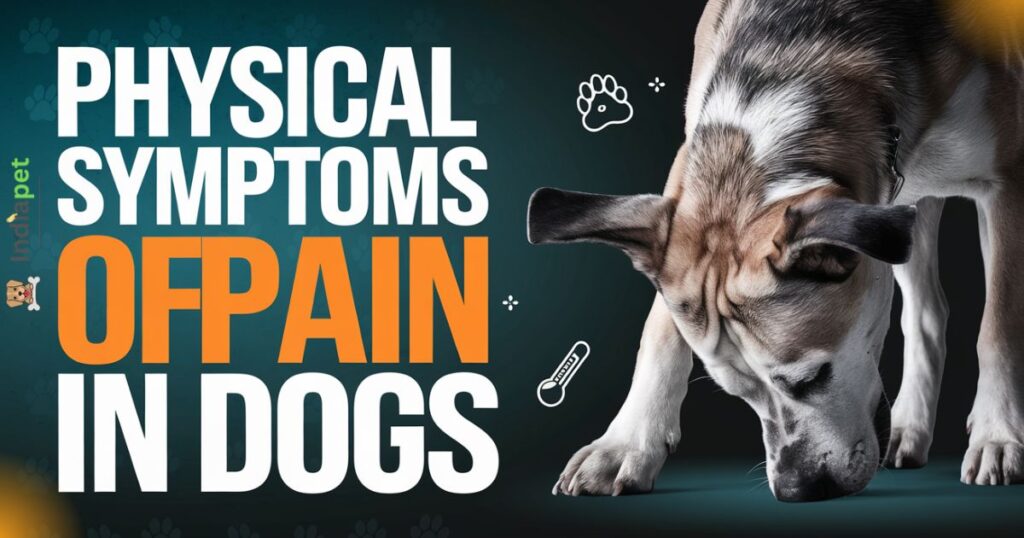Has your furry canine friend been acting strangely lately? Is he exhibiting unusual behaviour that you can’t quite explain? Your dog might be in pain. Knowing if your dog is in pain is a tough task.
As pet owners, we must be mindful of our pets’ well-being and recognize signs that they may feel uncomfortable. This article will explain common indications that your dog is actually in pain, which you can use to understand easily what is bothering your dog.
Common Indications That Your Dog Is Actually In Pain
In this video, you also get a How do I know if my dog is in pain, see this video if you do not want to read, but after reading, you understand in depth with full detailed information & proper guide.
Understanding Canine Pain
Dogs, or any living animal, feel pain like humans, but they often have difficulty expressing it. For pet owners, it’s important to understand the different types of pain that dogs experience. There are two main categories: acute pain, which occurs suddenly and for a short time, and chronic pain, which persists for a long time.
Injuries, surgeries, or other traumatic events can cause acute pain. On the other hand, chronic pain is often associated with conditions like arthritis, hip dysplasia, or cancer. So, it’s important to note that dogs can experience both types of pain simultaneously, making it even more challenging to identify their discomfort.

Signs and Symptoms of Pain in Dogs
Recognizing the signs and symptoms of pain in dogs is important for early intervention. While some signs may be more obvious, others can be subtle and easily overlooked. It is important to pay close attention to your dog’s behaviour, as they may not always communicate their pain in an easily recognizable way.
A common sign of pain in dogs is a change in appetite. If your dog suddenly loses interest in food or begins eating less, this could be a sign that he is experiencing discomfort or pain. Additionally, dogs in pain may display behavioural changes such as increased aggression, restlessness, or avoiding social interactions.

Behavioral Changes Indicating Pain
When your dog is in pain, their behaviour can change in several ways. One notable change is an increase in aggression. Dogs in pain may also become more defensive and irritable, snapping or growling when approached or touched. This behavioural change is their way of protecting themselves from further discomfort.
On the other hand, some dogs may become more isolated and avoid social interaction when they are in pain. They may prefer to isolate themselves in a quiet corner or hide in their favourite spot. This behavioural change is their attempt to find relief and reduce any potential triggers, but it may increase their pain.

Physical Symptoms of Pain in Dogs
In addition to behavioral changes, dogs in pain may also show physical signs that can give you an indication of their discomfort. A common physical sign of pain is excessive licking or rubbing of a particular area. This behaviour attempts to soothe the painful area, like rubbing a sore muscle.
Another physical sign to look out for is limping or difficulty moving. If your dog overuses one leg or struggles with certain movements, this could be a sign of joint pain or injury. Additionally, dogs in pain may yelp or groan when a particular area is touched, a sign of localized pain. Be especially careful about these things.

Common Causes of Pain in Dogs
A prevalent cause is musculoskeletal conditions such as arthritis or hip dysplasia. These conditions can cause chronic pain, stiffness and difficulty moving. Injuries such as sprains, fractures or torn ligaments can also cause dog pain. It is important to monitor your dog’s activity and be careful when playing to reduce the risk of such injuries. Teething, infections, or gastrointestinal problems can cause a dog pain and discomfort.

When to Seek Veterinary Care for Your Dog’s Pain
Some cases of pain in dogs can be treated at home, but there are also some situations where veterinary care is needed. If your dog shows severe symptoms like persistent crying, difficulty breathing or fainting, it is important to consult a veterinarian immediately.
It is best to consult your veterinarian. They can thoroughly examine and diagnose the root cause of your dog’s pain and recommend appropriate treatment options.
If your dog is showing any of the following symptoms, you should consult a veterinarian for pain:
- Rapid breathing can indicate severe pain from an injury or illness.
- Murt sounds: Your dog may groan, cry, scream, moan or grunt.
- Changes in activity level: Most commonly seen, the dog may be reluctant to move, slow down or hide.
- Abnormal behaviour: Your dog may become aggressive, withdrawn or have accidents in the house.
- Changes in body posture: Your dog may hunched over, lie on his side or protect a body part.
- Changes in self-care: Your dog’s coat may lack shine, or his hair may stand up in certain places.
- Self-harm: Your dog may lick, bite or scratch a particular part of his body.
- Vomiting: Severe vomiting can lead to dehydration or diarrhoea, so seek treatment as soon as possible.
- Loss of appetite: Your dog may suddenly stop eating, especially if he is experiencing pain around his mouth or face.
- Inability to pass stool: This is a veterinary emergency.
- Sudden weight loss may be a sign of a health problem that requires veterinary attention.
- Shivering or shaking: This can be a sign of pain or a symptom of a serious illness.
Home Remedies for Relieving Your Dog’s Pain
In addition to veterinary care, several home remedies can help alleviate your dog’s pain. However, it’s important to consult your veterinarian before trying home remedies to ensure they are safe and appropriate for your dog’s specific condition.
One effective home remedy for pain relief is heat or cold therapy. Applying a warm compress or an ice pack to the affected area can help reduce inflammation and provide temporary relief. Additionally, providing your dog with a comfortable and supportive bed can help alleviate joint pain and improve their overall comfort.
Treatment Options for Managing Pain in Dogs
Regarding managing pain in dogs, various treatment options are available. Your veterinarian may prescribe medication such as nonsteroidal anti-inflammatory drugs (NSAIDs) or opioids to help manage your dog’s pain. These medications can provide relief and improve your dog’s quality of life.
In some cases, alternative therapies such as acupuncture, physical therapy, or hydrotherapy may be recommended to complement traditional pain management methods. These therapies can help reduce pain, improve mobility, and enhance overall well-being. It’s important to work closely with your veterinarian to determine the most suitable treatment plan for your dog.
Preventing Pain in Dogs
Prevention is always better than cure, and the same applies to preventing pain in dogs. Taking proactive measures to maintain your dog’s overall health can help prevent some conditions that can cause pain. Regular exercise, a balanced diet, and a healthy weight can help reduce the risk of musculoskeletal problems.
In addition, brushing your dog’s teeth regularly and scheduling professional cleanings can help prevent tooth pain and infections. Regular checkups with your veterinarian can also help identify potential health problems early, allowing for prompt intervention and pain prevention.
Conclusion
In conclusion, pet owners should be careful and knowledgeable about the signs and symptoms of pain in dogs. By understanding these signs, we can provide our furry companions with the care and comfort they need. When your dog is in pain, don’t forget to consult your veterinarian for proper diagnosis and treatment options; it is your responsibility, as you are your dog’s owner.
The dog should be given proper care and attention from time to time. After reading this, I hope you have understood the whole thing properly; if you liked this article on the 7 Common Indications that your dog is actually in pain, please share it with your friends and family.


